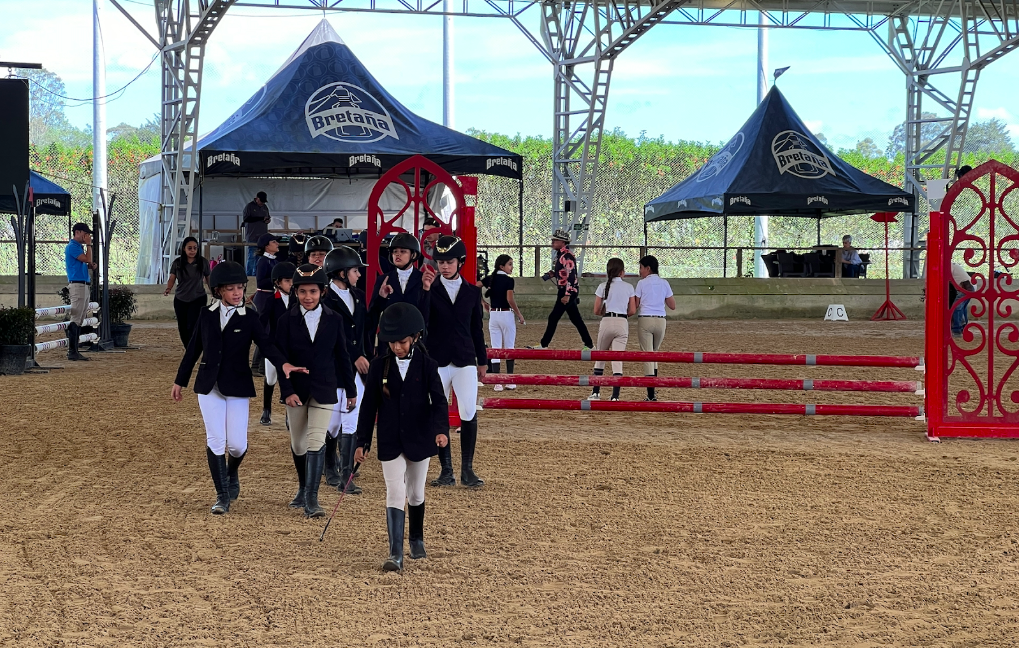The day starts with the blasting sound of the alarm. With the sun barely out, showjumpers gather their gear, carefully packing the essentials for the day. From riding boots to helmets, show jackets to spurs, each item is carefully chosen and packed. The thrill of the competition is all about getting on your horse, entering the arena, seeing the people you love on the sidelines cheering you on, and it being just you and your horse, giving it all you’ve got to get through the course. The world just stops.
Show jumping is a sport seen all around the world. In Colombia, cities like Medellín, Bogotá, and Cali have several clubs filled with binomials (a rider and a horse) that train daily preparing to compete. In Medellín, most of the year’s events are hosted in the Club Campestre. However, there are also national competitions where riders test their skills in other cities, as well as local tournaments where riders from outside the city participate.
“Even after all these years of training and competing, I still get nervous. I feel this pressure inside of me, eager to get it over with and do as best as possible,” Maria del Mar Cadavid, showjumper, said.
The sport involves persistence and dedication. Usually, the hour-long training sessions occur six days a week. This also depends on how many horses you ride, and how consistent you are with your training. The more you go, the more progress you will see. But don’t get fooled, it’s not easy, neither physically nor mentally. Like everything in life, horseriding has its ups and downs. You can train perfectly for weeks, and when it is time to compete, life has other plans. However, discipline is what makes athletes keep going, and at the end of the day, it all becomes rewarding when you see the results you achieve throughout your career, and knowing you have your companion there with you will always help.
“Nobody is perfect. We all have weeks where we want to quit just because we’re not feeling good, unmotivated, and maybe even slightly disconnected from the horse. It is in those moments where you have to push your hardest to keep going,” Ana Sofia Gomez, showjumper, said.
For many of the riders still in school, university, and even work, trying to find a balance between managing their time training and life outside the stable can be hard. On a regular day, school ends at around 3 pm and training begins around 4 or 5 pm. Show jumpers leave school and head directly to class, getting home around 6 or 7 pm. Not considering that it is necessary to stay in shape by going to the gym or performing some type of exercise as it will help your riding, and make injuries less prone. TCS understands that sometimes it gets out of riders’ hands when they have to attend a competition and miss school. For this, they have a program for high-performance athletes where any absences due to training or having a tournament will be excused.
“I’ve had times where I have a competition that is on the same week as the end of the bimester. Yes, some teachers understand and give extensions or maybe even exclude some formatives, but others aren’t as comprehensive. It’s hard but if I had to choose, I’d choose this sport a million times,” Senior Paulina Moreno said.
Competitions are held throughout show jumping obstacles, including verticals, oxers, or double and triple combinations, usually with many turns and direction changes. The intent is to jump cleanly over a set course within an allowed time. Time faults are assessed for exceeding the time allowance. If a pole is knocked over, it counts as four faults as well as a refusal, which is when a horse stops right before the jump. Show jumping works by categories which are then organized by height, ranging from 50 centimeters to around 1.60 meters. Some categories have a specific age requirement. However, others allow riders of any age to participate, with cases of a 13-year-old competing against an almost 70-year-old in the same class.
“Before we go in with our horse, we have to walk the course, memorizing the jumps and counting the strides between them. I’ve had a few times where I memorize the course perfectly, and when I enter the arena, my mind goes blank. Luckily I revise it quickly before the bell rings to start jumping, but I think it’s mostly the nerves that make me forget,” Salome Yepes, showjumper, said.
Many elements go into giving your horse the best care possible, such as keeping their hooves trimmed, working on them to strengthen their muscles, and stretching before or after training and jumping. It is also important to understand that horses need time to relax and be themselves. Taking them out for walks and letting them out in the pastures is what also keeps them healthy, both physically and mentally. Maintaining a balance of work and time off will help both you and your horse.
“This is one of the only sports that can last a lifetime. I truly enjoy everything it has to offer, the friends you meet along the way, the lessons it teaches you, and the connection you make with your horse,” Julieta Vásquez, showjumper, said.



